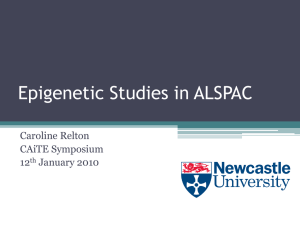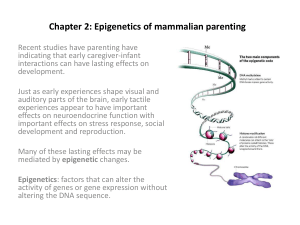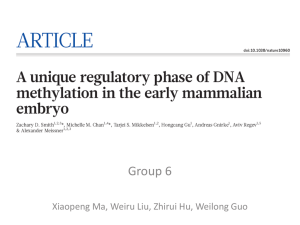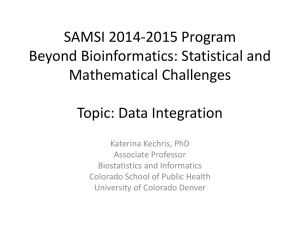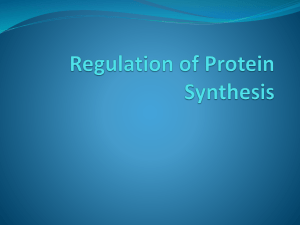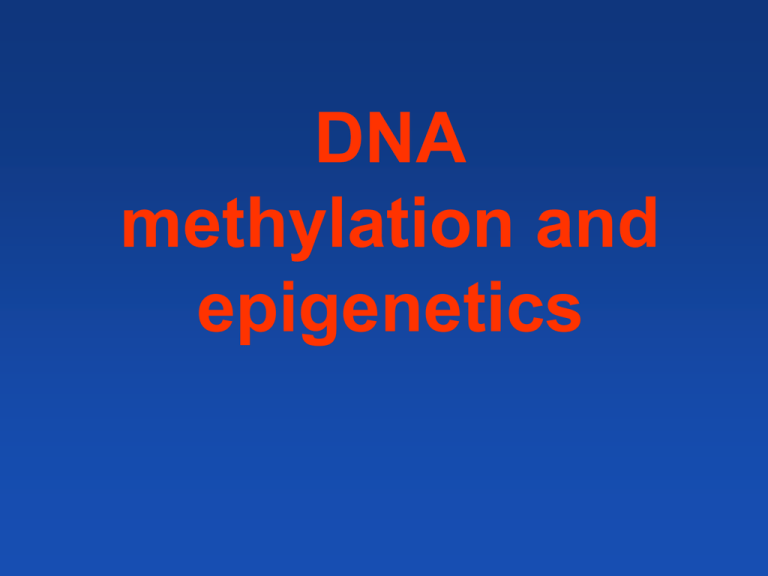
DNA
methylation and
epigenetics
DNA methylation in Eukaryots
Non-methylated DNA: Saccharomyces cerevisiae,
Drosophila, Caenorhabditis, ….
mammals: 3-8% cytosine residues, CpG sequences
(u embryonal stem cell also non-CG,
in brain alsohydroxymethylC)
plants: 25-30% cytosine residues (~ genome size)
- mainly in repetitive heterochromatinic regions
(non-methylated islands of gene-rich DNA in large genomes)
- metC (CG) even in coding sequences of transcribed genes
Epigenetics
Mitoticaly and/or meioticaly herritable changes in gene
function, which are not based on changes in primary DNA
sequence
Mechanism:DNA methylation
histon modifications (acetylation, methylation,..)
- Regulation of gene expression in development, parental
imprinting
- Transgene and TE silencing,
- Paramutations,
- Conformational changes in chromatin (keeping
heterochromatin structure)
Mechanism of DNA methylation
- in Eukaryots metylation of cytosin on C5(also adenin in bacteria)
H
H
H
N
N
O
cytosine
O
N
N
C
N
H
+ SAM
CH3
C
CH3
H
N
T
N
+ H2O O
- NH3
thymine
5-methyl cytosine
O
N
„hot spot of mutagenesis“
Genom Arabidopsis - statistics
Value
Feature
DNA molecule
Chr.1
Length (bp)
Top arm (bp)
Bottom arm (bp)
29,105,111
14,449,213
14,655,898
Base composition (%GC)
Overall
Coding
Non-coding
Number of genes
Gene density
(kb per gene )
Average gene
Length (bp)
Average peptide
Length (bp)
Exons
Number
Total length (bp)
Average per gene
Average size (bp)
Number of genes
With ESTs (%)
Number of ESTs
Chr.2
Chr.3
Chr.4
Chr.5
SUM
19,646,945
3,607,091
16,039,854
23,172,617
13,590,268
9,582,349
17,549,867
3,052,108
14,497,759
25,53,409
11,132,192
14,803,217
115,409,949
33.4
44.0
32.4
35.5
44.0
32.9
35.4
44.3
33.0
35.5
44.1
32.8
34.5
44.1
32.5
6,543
4.0
4,036
4.9
5,220
4.5
3,825
4.6
5,874
4.4
2,078
1,949
1,925
2,138
1,974
446
421
424
448
429
35,482
8,772,559
5.4
247
19,631
5,100,288
4.9
259
26,570
6,654,507
5.1
250
20,073
5,150,883
5.2
256
31,226
7,571,013
5.3
242
60.8
56.9
59.8
61.4
61.4
30,522
14,989
20,732
16,605
22,885
25,498
132,982
33,249,250
105,773
DNA methylation in plants – target sequences
- both symmetric (palindromatic) sekvence and asymmetric sequences:
5’ -------CG-------CNG----------C---C------G--C---- 3’
3’ -------GC-------GNC----------G---G------C--G---- 5’
Symmetric – methylation pattern easily kept after replication
hemimethylated state = signal for maintainance methylation
---------C*G ------------G C*----
-----C*G------------ C*NG-----------C*-----------G C-------------G NC-----------G -----------CG -------------CNG -----------C------------GC*-------------GNC*-----------G--------
Asymmetric – after replication de novo methylation (by another
signal – histon modification or presence of complementary sRNA)
Methylation analysis - hydrogensulphite
sequencing (NaHSO3)
1. denaturation
---------C---------C--------CC---C------C------------C--
2. modification of Cyt to Ura
(5metC remains unchanged)
---------C---------U--------UU---C------U------------U--
3. shotgun sequencing,
specific PCR + sequencing
original sequence
---------C---------C--------CC---C------C------------C----------G---------G--------GG---G------G------------G--
modified sequence
---------C---------U--------UU---C------U------------U----------G---------A--------AA---G------A------------A--
Analysis of methylation in Arabidopsis
„Chromosome epigenetic landscape“
Analysis of DNA methylation
in Arabidopsis
Strong methylation in heterochromatin near centromeres
MetC even in coding sequences of expressed genes!
(more than 30 % genes, middle expression)
Metylation in promotors of developmentally regulated
genes (less than 5 % genes)
Plant cytosine 5-methyltransferases
MET1 (metyltransferase)
CMT3 a CMT2
(chromomethyltransferases)
DRM2 (a DRM1)
(domain rearranged methyltransferase)
MET1 (metyltransferase1)
- related to mammalian Dnmt1
- maintenance methylation of symmetric CG
- asociated with replication
- involvement of nucleosom remodeling complex (DDM1)
(in heterochromatin)
Signal – hemimethylated CG (CpG)
---------C*G ------------G C*----
----C*G------------- C*HG---------- C* ---------- G C------------ G DC-----------G -----------CG -------------CHG -----------C------------GC* -------------GDC*-----------G--------
CMT3 (chromomethyltransferase3)
- unique for plants and fungi
- related to mammalian Dnmt1 + chromodomain (meK)
- mainly constitutive heterochromatin (repeats, retroTEs)
- „maintenance“ methylation of CHG
Activity associated with methylation of histon H3K9
---------C*G ------------G C*----
----C*G------------- C*HG---------- C* ---------- G C------------ G DC-----------G -----------CG ------------- CHG -----------C------------GC* -------------GDC*-----------G--------
CMT2 (chromomethyltransferase2)
- related to CMT3 (chromodomain - meK)
- mainly constitutive heterochromatin (repeats, retroTEs)
- „maintenance“ methylation of CHH
Activity associated with methylation of histon H3K9
---------C*G ------------G C*----
----C*G------------- C*HG---------- C* ---------- G C------------ G DC-----------G -----------CG ------------- CHG -----------C------------GC* -------------GDC*-----------G--------
DRM2 a 1 (domain rearranged methyltransferase)
- related to mammalian Dnmt3, but with rearranged domains,
- de novo methylation of all sequences (CG, CNG, asymmetric)
- DRM1 – early seed development, DRM3 inactive (but necessary)
- maintenance methylation of asymetric and CNG
- regulation of gene expression, silencing
Targed sequences determined by the presence of complementary
siRNA
-
---------C*G ------------G C*----
----C*G------------- C*HG---------- C* ---------- G C------------ G HC-----------G -----------CG -------------CHG -----------C------------GC* -------------GHC*-----------G--------
RNA directed DNA methylation
AGO4 – ARGONAUTE (carrying ss small RNA)
DRM2 – de novo metyltransferase
DRD1 – chromatin remodelling protein
PolV – special RNA polymerase
Maintenance methylation of DNA
Heterochromatine with histone H1
- middle part of longer TE (coding region)
- chromatine remodelling factor DDM1 required
- methylation driven with:
H3K9me2 (CHH, CHG) – CMT2, CMT3
CG hemimethylation – MET1
Chromatine without histone H1
- TE borders, short TE, genes
- chromatine remodelling factor DRD1 required
- methylation driven with:
siRNA (RdDM) – DRM2
(RdDM – H3K9me2, demet. H3K4, see later)
CG hemimethylation – MET1
Maintenance methylation of TE
Zemach et al. 2013
DNA demethylation
1) by inactivation of maintenance enzymes after replication
(MET1, CMT2, CMT3, histon methylatransferases)
2) DNA glycosylases
(cleavage of methylcytosine, cytosine incorporated by reparation)
ROS1 (REPRESSOR OF SILENCING) – somatic cells
(RNA binding ROS3 required – unknown function)
DML2, DML3 (DEMETER-LIKE) – somatic cells
DME1 (DEMETER) – parental imprinting (endosperm)
DNA demethylation
ros1 dml2 dml3
increase in
methylation
ROS1, DML2, DML3)
- mutation in „demethylation“ genes
→ increased methylation in 3’ and 5’ UTR
- protection of genes (promoters)
against methylation
(alt. modulation of transcription)
methylation
WT
In methyltransferase mutants – demethylation inhibited (feed
back regulation)
Modulation of DNA methylation
- inactivation of methyltransferase genes MET1, DDM1, CMT3
- application of 5-azacytidine – inhibits MET1
- dihydroxypropyladenine (DHPA) – modulates [SAM]
Fenotypic changes connected with demethylation:
- variable: from negligible to strong (caused by activated TE)
- sex reversion reversion,
- cycloidea phenotype
(hypermethylation)
Reactivation of silenced
(trans)genes by 5-azacytidine
hemiMet?
- inhibitor of MET1 (5-azacytidine, AzaC)
deMet
+ AzaC
+ AzaC
Demethylated
- reactivation often only transient!
Nocarová, Fischer, unpubl.
Interpretation of DNA methylation
•
steric consequences of cytosine methylation
changes on the histone level
- posttranslational modifications of histones
- SRA domains: metylace (SUVH family),
- Metyl CpG-binding d.: deacetylation (HDAC)
- presence of histone forms (H2A.Z)
•
changes in binding of interacting proteins
- regulators of transcription
- proteins involved in structural modifications of chromatin
example: MBD proteins
(metyl-CpG-binding domain)
- plant MBD proteins lack TRD
(transcription repression domain)
- specificity of binding affected with
other interacting proteins
- AtMBD5 interacts also with C*HH
- MBD probably interact with histone
modifying proteins (HDAC
= histon deacethylases → inactivation)
Model of chromatin compression
by dimerazing AtMBD7 protein
Autocatalytic loop
CHG methylation (CMT3) and H3K9 methylation(KYP, KRYPTONITE)
- transcription induces demethylation H3K9me2 by IBM1)
ROS1/
ROS3
???
x
DRM2
- similar decrease in H3K9me2 in kyp a cmt3
DNA methylation and chromatin
- overview
- correlation between DNA hypermethylation and
hypoacethylation of histons and chromatin condensation
(later replicated DNA)
- inhibition of DNA methylation (MET1) and histone
deacethylation (AtHD1) cause similar changes
- presence of histone H2A.Z (promoters of active genes)
mutually exclusive with DNA methylation!
DNA methylation and chromatin
- overview
- H3K9 di(tri-)methylation (KYP) signal for CHG methylation
- CHG methylation signal for H3K9 methylation
- H3K9 demethylation (IBM1) likely induced by transcription
- H3K4 trimethylation typical for euchromatin, induced by
transcription
Maintenance of epigenetic state overview
inactive chromatin
- MET 1 – maintenance methylation of C*G
- KYP (SUVH5,6) – H3K9me2 CMT3 - C*HG (CMT2 – C*HH)
- DRM2, (DRM1) – maintenance met. CHH complementary siRNA
Aktivní chromatin
- IBM1 – demethylation of H3K9 transcription
- ROS1/ROS3, DML2, DML3 – demetC transcription, sRNA?
Interconnections among DNA
methylation and chromatin
structure
histone posttranslational
modifications
and forms
metC =
dsDNA
modification
binding of
interacting
proteins
TF, RNA pol.,
MBD, …
Roles of DNA methylation
- herritable (mitotic and partially even meiotic modulation of
transcription – gene expression
- defence against invazive DNA (TE)
- regulation of gene expression (ontogenesis, differenciation,
cell memmory, stress reaction)
- parental imprinting
- modulation of chromatin structure (both - cause and result)
- timing of DNA replication
- regulation of homologous recombination (meiosis)
- tool of evolution
- genomes of polyploids (methylation changes)
- new genes (mutagenesis of pseudogenes)


